
Nudibranchs are a group of soft-bodied marine gastropod molluscs that shed their shells after their larval stage. They are noted for their often extraordinary colours and striking forms, and they have been given colourful nicknames to match, such as "clown", "marigold", "splendid", "dancer", "dragon", and "sea rabbit". Currently, about 3,000 valid species of nudibranchs are known.

Glaucus atlanticus is a species of small, blue sea slug, a pelagic (open-ocean) aeolid nudibranch, a shell-less gastropod mollusk in the family Glaucidae.

Aeolidia papillosa, known as the common grey sea slug, is a species of nudibranch in the family Aeolidiidae.
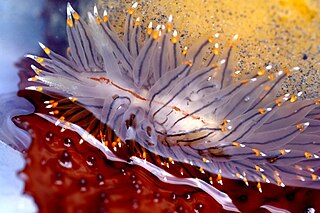
Janolus fuscus is a species of sea slug, or more accurately a nudibranch, a marine gastropod mollusk in the family Proctonotidae.
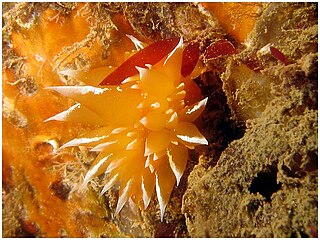
Dirona pellucida is a species of sea slug, a northern Pacific Ocean nudibranch, a marine, opisthobranch gastropod mollusk in the family Dironidae.

Polycera faeroensis is a species of sea slug, a dorid nudibranch, a shell-less marine gastropod mollusk in the family Polyceridae.
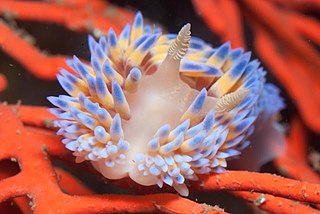
The gasflame nudibranch is a very colourful species of nudibranch, or sea slug. It is a marine gastropod mollusc in the family Proctonotidae. Bonisa nakaza is the only species in the genus Bonisa.

Thecacera is a genus of sea slugs, specifically nudibranchs, shell-less marine gastropod mollusks in the family Polyceridae.

The crowned nudibranch is a species of dorid nudibranch. It is a marine gastropod mollusc in the family Polyceridae.

Doto coronata is a species of small sea slug or nudibranch, a shell-less marine gastropod mollusc in the family Dotidae. It is the type species of the genus Doto.

Leptogorgia virgulata, commonly known as the sea whip or colorful sea whip, is a species of soft coral in the family Gorgoniidae.
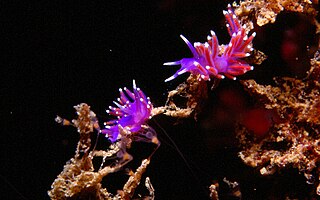
Edmundsella pedata is a species of sea slug, an aeolid nudibranch, a marine gastropod mollusc in the family Flabellinidae.
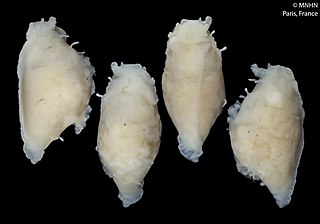
Okenia zoobotryon is a species of sea slug, a dorid nudibranch, a marine gastropod mollusc in the family Goniodorididae. It is normally found on the colonial bryozoan Amathia verticillata on which it lives and feeds.
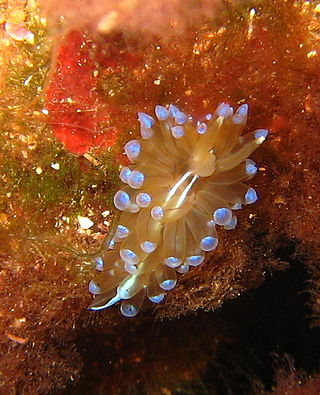
Antiopella cristata, sometimes known by the common name crested aeolis, is a species of nudibranch, a marine gastropod mollusc in the family Janolidae.
Okenia mediterranea is a species of sea slug, specifically a dorid nudibranch, a marine gastropod mollusc in the family Goniodorididae.

Polycera atra, common name orange-spike polycera or sorcerer's sea slug, is a species of sea slug, a nudibranch, a marine gastropod mollusk in the family Polyceridae.

Onchidoris proxima is a species of sea slug, a dorid nudibranch, a shell-less marine gastropod mollusc in the family Onchidorididae. This species is found in the northeastern and northwestern parts of the Atlantic Ocean. It is also reported from the northeastern Pacific Ocean. Previously in the genus Adalaria this species was moved to Onchidoris as a result of a molecular phylogeny study.

Aeolidiella alderi is a species of sea slug, an aeolid nudibranch in the family Aeolidiidae. It is native to northwestern Europe where it occurs in the intertidal zone. It is a predator and feeds on sea anemones.
Bicellariella ciliata is a species of bryozoan belonging to the family Bugulidae. It is found in shallow water on both sides of the Atlantic Ocean, the Mediterranean Sea and the Indo-Pacific region.
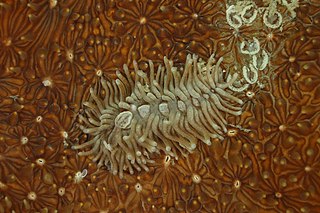
Phestilla viei is a species of coral-feeding sea slug, an aeolid nudibranch, from the family Trinchesiidae, described in 2020. It has been identified as a sister species of Phestilla fuscostriata based on DNA barcoding using the COI gene. The genus Phestilla currently includes nine recognized species, eight of which are obligate corallivores, with each particular species predating on only one species or genus of coral. Its distribution is restricted to the Indo-Pacific Ocean.


















